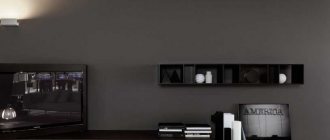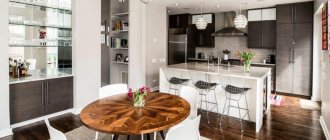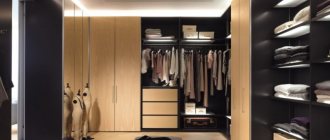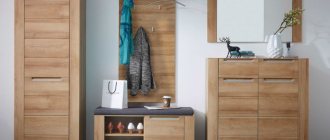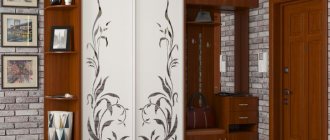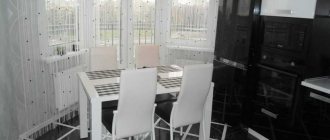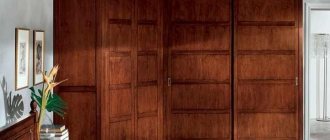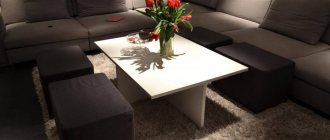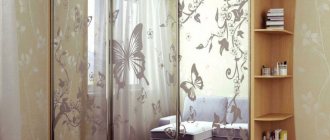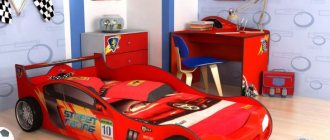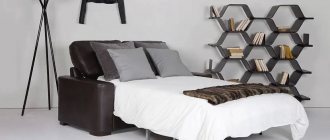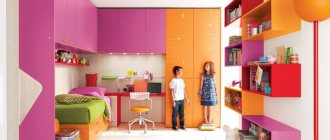<
>
Furnishing a nursery is not complete without choosing a cabinet. Furniture here should not only be practical and safe. It is important that the little owner likes it. In this case, the cleaning process will be fun and not burdensome. Developing independence in a child while arranging personal belongings will be an additional advantage of purchasing expensive furniture.
Types and sizes of cabinets
As you can see in the photo of nursery cabinets, they come in a variety of shapes, sizes and designs. When choosing, you should carefully study all the features of the model, taking into account the needs of the child and the characteristics of the room.
The most popular types of cabinets include:
- Free-standing cabinets. The most popular and widespread type. The cabinet can be installed almost anywhere in the room. Usually it is placed against one of the walls. As a rule, these are quite tall models - from 180 cm. The standard width is 80 cm, but there are also larger options. The depth is 45-60 cm. Typically the closet has 2 doors, shelves and a hanging bar.
- Built-in. An ideal choice for compact spaces. The function of the rear, top, bottom and side panels (one or both) is performed by the walls of the room. Such cabinets can be equipped with both hinged and sliding doors. The disadvantage is that you cannot move to another location.
- Wardrobe as part of multifunctional furniture. This could be a closet attached to a bed or table. Also a good solution for compact rooms as it takes up less space.
- Angular. They are installed in one of the corners of the room, as a rule, they have a triangular or L-shaped design. A corner wardrobe in a nursery allows you to rationally use space that is usually empty, thereby saving useful space in the room.
- Modular. The product is an element of a modular system consisting of separate sets (bed, wardrobe, table, shelves, etc.) made in the same style.
Sizes may vary significantly. Many manufacturers provide the opportunity to change the dimensions of standard models to suit individual needs.
The height is usually 1.7-2 m, depth - 45-60 cm, width - from 80 cm.
Let's look at a suitable option
Below we have collected for you the most common types of designs and designs. Based on your needs and interior design solutions.
Note!
Children's bed-type car: a selection of the best ideas for the interior of a nursery. Advantages and disadvantages, description of types and models with photo/video review- Beautiful furniture for a children's room: new trends in interior design with photo/video reviews and tips from the best designers
A beautiful ceiling in a nursery - the best photo examples of modern design. Practical lighting tips (video instructions)
Internal filling of the cabinet
A closet in a nursery for clothes and other things should be as functional and practical as possible, which directly depends on its internal layout. You should choose a model that allows you to accommodate as many different things as possible.
The internal filling of the cabinet may consist of the following elements:
- Barbell. Metal pipe for hangers with clothes. There are models in which the height of the bar can be adjusted to suit the height of the child.
- Open shelves. Used for storing folded linen and clothes. It is better to choose a model with shelves of different heights and widths.
- Drawers. Optimal systems for storing linen and small items.
- Baskets or containers. Allows you to conveniently store shoes and hats.
- Mezzanine. For storing rarely used items.
When choosing internal filling, you should take into account the gender and individual needs of the child. For a boy, a few shelves for clothes, a compartment for shoes and a hanging rod are usually enough. A girl may need much more shelves to store shoes, boots, bags and all kinds of accessories.
The internal content directly depends on the dimensions of the model. The larger the cabinet, the more varied its configuration can be. For example, compact models usually do not have containers and baskets for hats and shoes.
With bed
On the top tier there is a loft bed, on the bottom there is a wardrobe. The ladder is usually located on the side and can be removable. A convenient option if there is not much space in the room, but you plan not to limit yourself to buying a cabinet.
There are designs in which there is a bed at the bottom and a wardrobe at the top. In the latter case, the bed can even be folded out, saving even more space.
Manufacturing materials
When choosing a wardrobe for a nursery, it is important to consider not only the quality and durability, but also the safety of the materials.
Most often used for the production of cabinets:
- Tree. The most reliable, durable, environmentally friendly and durable material. But, solid wood cabinets usually have a relatively high cost.
- Chipboard. The most budget solution. Chipboard cabinets can have any design (due to the imitation of various textures) and construction. The main disadvantage is relatively low strength.
- Laminated chipboard (LDSP). Due to lamination, the material is more resistant to moisture and mechanical damage.
- MDF. Medium price material. Significantly superior to chipboard in strength and durability, but slightly inferior to wood in these parameters. Resistant to moisture.
Fittings are usually made of metal and plastic. It is important that it is reliable and easy to use.
Glass can be used, for example, to create mirrored facades. It is important that the glass is impact-resistant to eliminate the risk of injury to the child.
Opening system
There are several basic cabinet opening systems:
- Hinged doors. The classic version, the doors are installed on metal hinges. Such cabinets are easy to use, but require more free space to open the doors.
- Coupe (sliding). A sliding wardrobe for a children's room is the most modern and practical solution. The cabinet is equipped with sliding fronts that move along guide rails. Such models attract with a more modern design and compactness. They do not require additional space to open the doors. The facades can be mirrored, decorated with photo printing or various patterns.
- Harmonic. The doors are made of several parts that fold like an accordion. When opening and closing, they require additional free space, but not as much as swing models.
With a table
The table is part of the cabinet and is built into its structure. When choosing a children's table with a cabinet, pay attention to the convenience of each individual part.
Combined models should be convenient both for studying and for storing some things, otherwise there is no need for furniture that looks good, but in fact does not fulfill the requirements set for it.
The design may seem unnecessarily bulky and impede possible rearrangement. And it’s worth thinking about what benefits you want to get from such a solution. So that everything is at hand? To save on the cost of a product?
Design and colors
Manufacturers offer cabinets for children's rooms in various styles.
The most popular include:
- Minimalism and hi-tech. Simple regular shapes and clear lines, a minimum of decor. The colors are often one-color or two-color.
- Scandinavian. A universal solution for children of any age. Such cabinets are usually made from natural materials in light colors.
- Provence. A stylish solution for girls, since the main features of the style are tenderness and sophistication. The cabinets are made from natural materials in pastel colors.
- Space style. Current solution for boys aged 7-15 years. Such cabinets often have a non-standard design, for example, in the shape of a rocket. The style is characterized by the use of laminated and mirror surfaces. The cabinet can be made in bright colors - blue, purple, dark gray, green and the like.
Children's rooms are usually not decorated in a classic style, which is why cabinets with this design are not popular. Children like the bright, attractive design of furniture and the room as a whole, which is not typical for classics.
It is important that the design of the cabinet fits harmoniously into the overall style of the room. It should match well in color and shape with other furniture.
Therefore, they often buy modular systems, all elements of which are made in the same color. When choosing a design, it is important to take into account the gender, age and personal preferences of the child.
How to arrange clothes
To make it convenient for your child to use the closet, remember a few simple recommendations:
- The hanger bar is placed at a convenient height. The child should feel like a full-fledged owner, take off and hang clothes independently.
If the child is small, place the bars at the bottom
- Shelves can take up space from top to bottom . But things that are used every day should be placed at a level convenient for the child. The rest is laid out higher.
- Drawers are located either on the middle level or at the bottom . It is important here that the extension system works smoothly and does not warp. Above we showed how to properly organize space. Some models have ready-made compartments for small items, which is very convenient.
Small cells allow you to maintain perfect order when storing small items
